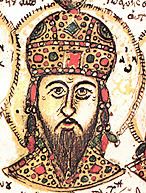Predecessor John V Name John Palaiologos Dynasty Palaiologos | Successor John V | |
 | ||
Reign 14 April – September 1390 Died September 22, 1408, Thessaloniki, Greece Parents Andronikos IV Palaiologos, Keratsa of Bulgaria Grandparents Ivan Alexander of Bulgaria, John V Palaiologos, Sarah-Theodora, Helena Kantakouzene Great-grandparents John VI Kantakouzenos Similar People | ||
Children Andronikos V Palaiologos | ||
John vii palaiologos
John VII Palaiologos or Palaeologus (Greek: Ιωάννης Ζ' Παλαιολόγος, Iōannēs Z' Palaiologos; 1370 – 22 September 1408) was Byzantine Emperor for five months in 1390. While he was Emperor, there is evidence showing he used the name Andronikos, after his father, although when he was regent during his brother's absence in the West, he governed in his birth name.
Contents
John VII Palaiologos | Wikipedia audio article
Life
John VII Palaiologos was the son of Emperor Andronikos IV Palaiologos and Keratsa of Bulgaria, a daughter of Emperor Ivan Alexander of Bulgaria and Theodora of Wallachia. He should not be confused with his cousin John VIII Palaiologos, the son of his uncle Manuel II, who succeeded his father.
When his father Andronikos IV usurped the throne from his father John V Palaiologos in 1376, John VII was associated as co-emperor the following year. Both father and son were overthrown and partly blinded in 1379, but Andronikos IV kept his imperial status and was granted Selymbria (Silivri) as his domain by John V. When Andronikos IV died in 1385, John VII perhaps succeeded to his father's position.
On 14 April 1390 John VII Palaiologos ousted his grandfather John V and maintained himself on the throne for five months, until John V was restored by his son Manuel with the help of the Republic of Venice
John VII sought refuge with Bayezid I of the Ottoman Empire on 17 September 1390. Bayezid confirmed John VII in his father's domain of Selymbria, and relations improved with Manuel II, who may have recognized John VII as his intended heir (at that time his own sons were not yet born).
In 1399, after Bayezid I had besieged Constantinople for some five years, Manuel II left to ask for military aid in Western Europe and left John VII as regent to defend the capital. John VII discharged his duties well, hoping for a miracle, which occurred when Bayezid was defeated by Timur at the Battle of Ankara (20 July 1402).
The defeat was followed by a civil war in the Ottoman Empire, as rival Ottoman princes sought peace and friendship with the Byzantine Empire. Taking advantage of this time of Ottoman weakness, John VII entered into a treaty that secured the return of much of the Turkish-occupied coast on the European side of the Sea of Marmara, with a special concession of the city of Thessalonica on the Aegean Sea. Thessalonica had been governed by Manuel II before its conquest by the Turks in 1387. On Manuel II's return John VII dutifully returned power to him and was allowed to retire to Thessalonica, which had been recently ceded back to Byzantium. There he governed as a semi-independent ruler for the rest of his life (1403–1408), using the title "Emperor of All Thessaly". John VII was allowed to keep the title of emperor (Basileus), and he associated his own young son, Andronikos V (born about 1400), with him at an uncertain date, but Andronikos V predeceased his father in 1407.
Family
By his wife Irene Gattilusio, John VII Palaiologos had at least one son:
- Andronikos V Palaiologos, Byzantine emperor (co-emperor)
